
Carsten Goering Infra
Leipzig 22 Jun – 4 Aug 2018
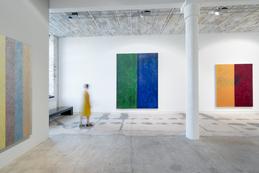
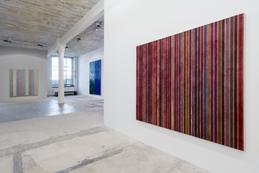
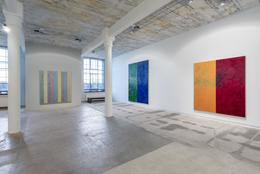
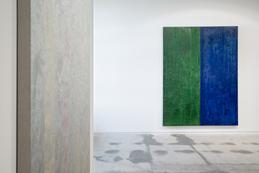
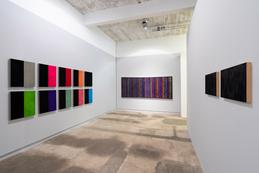
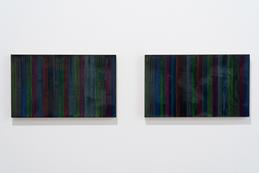
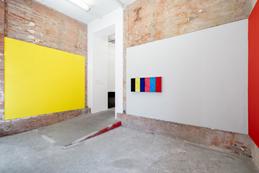
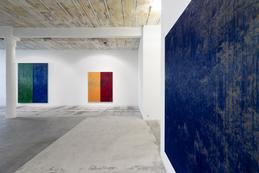
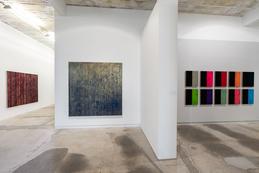
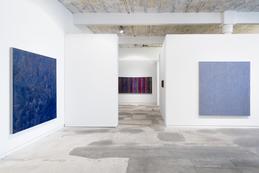
Carsten Goering’s works are full of movement. Derived from the traditional painting process - colour pigment on ground - their effect unfolds along with the movement of the viewer. This means not only in the viewer’s relative position to the picture as an object but also through the dynamics of their own eyes. It is a striking effect: an active movement triggered on the picture’s surface between light and shadow, colour and haptics, achieved through Goering’s carefully controlled application of colour and composition.
Goering creates a restrained lustre of heavy velvet or brocade and at the same time pulsating waves and ripples, close to an optical illusion, a gif or hologram. Imitating the wave character of light and its interference properties, the shimmering, fluttering and rippling of the paintings testify to the origin of Goering's work; media and computer painting, as well as neo-constructivism.
Goering has experimentally tested his formats and surfaces. Starting with the neutral square (approx. 2 x 2 meters) with maximum surface concentration, he has now partly developed into extreme landscape formats. Paper, wood, various textile fabrics such as jute, canvas or polyester all contribute to the effect. A work contains up to fifteen layers of colour and up to five works are created simultaneously. A first layer of rabbit skin glue is coated with chalk and acrylic, which is then grinded to a flat surface and covered by coloured glazes until the final mass application of colour pigments builds up its unique surface structure.
The colour field is Goering's subject matter. Its depth, the mood and the harmony or contradiction of the colour levels are very personal statements for Goering. The connotations of a single colour - from vivacious, rich and loud, sometimes poisonous and metallically brilliant to pastel, transparent and gently compressed - are exploited through his technique, spread across a length of up to three metres.
In addition to his monochrome works, we might see two colour figures standing next to each other in dialogue or in collision with one other in a powerful colour conflict. In other works, up to 30 panels are added as a kind of optical staccato, combined through an interchanging brightness and temperature. Goering’s serial work enables us to experience these contrasts as emotional expressions: the fractions, transitions and complementary connections continually resonate with the viewer.
As works of art, the works have an object-like character. On the one hand this is due to the modelling of the thick colour layers into relief- a sculpture-like corporeality- and on the other hand, by the approximately 7 cm thick frame, that emphasises the contrast of the colour surface against the surrounding raw canvas. Goering's non-objective painting is not a geometric dissolution of form and visual pictorial space, or even a departure from representation of external reality. Instead, it is built on an intrinsic value of colour, form and the rhythmisation of the picture surface. Goering’s work examines the unique possibilities at the point where a painting begins: colour as a fabric on a carrier medium.
Goering’s work is strongly connected to Kasimir Malevich, who developed suprematism, an art movement that detaches painting from the concept of representation, as well as to colour field, radical and hard-edge painting: all propose a redefinition within the painted monochrome colour surface. However, Goering is not trying to generate a "zero form", rather his work is comparable to the optical effects and abstract patterns of Op Art, such as the neutral-grey panels by Alan Charlton or works by the American minimalists Robert Mangold and John McLaughlin. Goering’s work can also be viewed in relation to the primary structures of the ZERO artists; their light-kinetic objects resonate with Goering’s examination of the space between painting and sculpture.
Carsten Goering's works, which are created not only by hand but also from the body, can be experienced as a process, almost as a film. The aesthetics resulting from his special painting technique demand a versatile point of view. In this way both the subject and theme of his paintings become just as important as the 'observer mode'; the works can be grasped both by closer inspection and paradoxically at the same time while quickly passing by.
Text by Tina Simon, 2018
Goering creates a restrained lustre of heavy velvet or brocade and at the same time pulsating waves and ripples, close to an optical illusion, a gif or hologram. Imitating the wave character of light and its interference properties, the shimmering, fluttering and rippling of the paintings testify to the origin of Goering's work; media and computer painting, as well as neo-constructivism.
Goering has experimentally tested his formats and surfaces. Starting with the neutral square (approx. 2 x 2 meters) with maximum surface concentration, he has now partly developed into extreme landscape formats. Paper, wood, various textile fabrics such as jute, canvas or polyester all contribute to the effect. A work contains up to fifteen layers of colour and up to five works are created simultaneously. A first layer of rabbit skin glue is coated with chalk and acrylic, which is then grinded to a flat surface and covered by coloured glazes until the final mass application of colour pigments builds up its unique surface structure.
The colour field is Goering's subject matter. Its depth, the mood and the harmony or contradiction of the colour levels are very personal statements for Goering. The connotations of a single colour - from vivacious, rich and loud, sometimes poisonous and metallically brilliant to pastel, transparent and gently compressed - are exploited through his technique, spread across a length of up to three metres.
In addition to his monochrome works, we might see two colour figures standing next to each other in dialogue or in collision with one other in a powerful colour conflict. In other works, up to 30 panels are added as a kind of optical staccato, combined through an interchanging brightness and temperature. Goering’s serial work enables us to experience these contrasts as emotional expressions: the fractions, transitions and complementary connections continually resonate with the viewer.
As works of art, the works have an object-like character. On the one hand this is due to the modelling of the thick colour layers into relief- a sculpture-like corporeality- and on the other hand, by the approximately 7 cm thick frame, that emphasises the contrast of the colour surface against the surrounding raw canvas. Goering's non-objective painting is not a geometric dissolution of form and visual pictorial space, or even a departure from representation of external reality. Instead, it is built on an intrinsic value of colour, form and the rhythmisation of the picture surface. Goering’s work examines the unique possibilities at the point where a painting begins: colour as a fabric on a carrier medium.
Goering’s work is strongly connected to Kasimir Malevich, who developed suprematism, an art movement that detaches painting from the concept of representation, as well as to colour field, radical and hard-edge painting: all propose a redefinition within the painted monochrome colour surface. However, Goering is not trying to generate a "zero form", rather his work is comparable to the optical effects and abstract patterns of Op Art, such as the neutral-grey panels by Alan Charlton or works by the American minimalists Robert Mangold and John McLaughlin. Goering’s work can also be viewed in relation to the primary structures of the ZERO artists; their light-kinetic objects resonate with Goering’s examination of the space between painting and sculpture.
Carsten Goering's works, which are created not only by hand but also from the body, can be experienced as a process, almost as a film. The aesthetics resulting from his special painting technique demand a versatile point of view. In this way both the subject and theme of his paintings become just as important as the 'observer mode'; the works can be grasped both by closer inspection and paradoxically at the same time while quickly passing by.
Text by Tina Simon, 2018
Artists